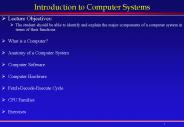Computer Languages - PowerPoint PPT Presentation
1 / 18
Title: Computer Languages
1
Computer Languages
- Computing
2
Machine Code
- The only type of program a computer can run is a
machine code program. - which looks like this.
3
Low Level Languages
- Low-level languages were developed to make it
easier for programmers to write and edit programs.
- Each machine code instruction is given a
mnemonic.
4
Assembler
- A Low level language is often called an Assembly
Language. - A computer cannot run an Assembly Language
program. - An Assembler converts an Assembly Language
program into machine code then the computer can
run it.
5
Assembly Language
- It takes many instructions to perform simple
tasks. - Assembled programs run fast so needed for Eg.
Games.
..but Assembly language programming is still hard
workso.
6
High Level Languages
- A high level language uses recognisable
instructions closer to English! - It is easier for programmers to develop and edit
high level programsand this will mean faster
program development. - and fewer bugs!
7
Program Translators
- A High level language program need to be
translated into machine code programs before a
computer can run it. - Compilers translate high level language source
code into executable object code programsthat
the computer can run. - Interpreters translate each line of a high level
language program, running each instruction as it
does so.
8
Examples of High Level Languages
- FORTRAN (FORmula TRANslator) used for
scientific computing. - ALGOL (ALGOrithmic Language)
- COBOL (Common Business Orientated Language) used
for commercial programming. - BASIC (Beginners All-Purpose Symbolic
Instruction Code) a learning language. - PASCAL A well-structured teaching language.
- C, C, C, C - Evolved from Algol.
- JAVA Popular language used for teaching
programming - and many, many more..
9
High Level Languages
- Scientific languages would have powerful
mathematical functions, and facilities for high
precision arithmetic to many decimal places - Commercial languages would have many data
processing functions (searching and sorting) and
filing facilities.
10
HTML
ltbody bgcolorbluegt lttablegt lttrgt lttdgtltfont
facearial colorredgtRonaldoslt/fontgtlt/tdgt lttd
gtltfont facearial colorwhitegtFirst
Pagelt/fontgtlt/tdgt lt/trgt lttrgt lttdgtltimg
srcc\ronaldo.jpg alignrightgtlt/imggtlt/tdgt lt/t
rgt lt/tablegt lta hrefpage2.htmgtPage 2lt/agt lt/bodygt
- ..stands for HyperText Markup Language.
- .... is used to develop web pages. A web page is
really a program written in HTML with
instructions for the web browser telling it how
to display the page. - Hyperlinks can be used for navigation between web
pages. - Multimedia objects can be embedded in a web page.
11
Special-Purpose Languages
- Some languages have a special purpose such as
- PROLOG for Artificial Intelligence
- GASP - for Simulation
- OCCAM for parallel processing systems.
- ADA for programming embedded systems.
12
Procedural Languages
- A sequence of instructions is executed.
- use variables, program control (loops etc) and
subroutines. - Examples PASCAL, BASIC, FORTRAN, COBOL, ALGOL.
13
Non-Procedural Languages
- A set of facts
- and a set of rules, from which information is
deduced.
14
Example (Non-procedural Language)PROLOG
- Facts
- Parent(Tom, Bob)
- Parent(Pam,Bob)
- Male(Tom)
- ..and a set of rules
- Father(X,Y)
- parent(X,Y)
- Male(X)
- Brother(X,Y)
- parent(Z,X)
- Parent(Z,Y)
- Male(X)
and a query which is answered by applying the
facts and rules ? father(who,Bob) who Tom
15
Object Oriented Programming Languages (OOPs)
- Objects have Properties and Methods.
- Properties can be set initially or at run-time.
- Methods are the things the object can do.
Examples of OOPs C, VB .NET, JAVA, PHP, PYTHON)
16
Fundamentals of an OOP
- A Class defines the properties and methods of
something.A DOG is a class Properties may
include Colour, Breed, No of Legs, etc Methods
may be Bark, Eat, Run, Sit, etc.. - An Object is a particular instance of a
Class.LASSIE is an instance of a DOG - A Sub-Class may be defined such as SPANIEL that
INHERITS the methods and properties of the Class
DOG.
17
Visual Languages
- Visual Languages allow the programmer to
manipulate objects visually on a form, and set
their layout and properties. - Often used to create Microsoft Windows
Applications. - Examples Visual Basic, Visual C, Delphi.
18
ALL programming languages must have
- International Standards.
- Difficult to create because of different hardware
and software manufacturers. - An unambiguous syntax.
- There should never be two different ways for a
computer to interpret an instruction.































